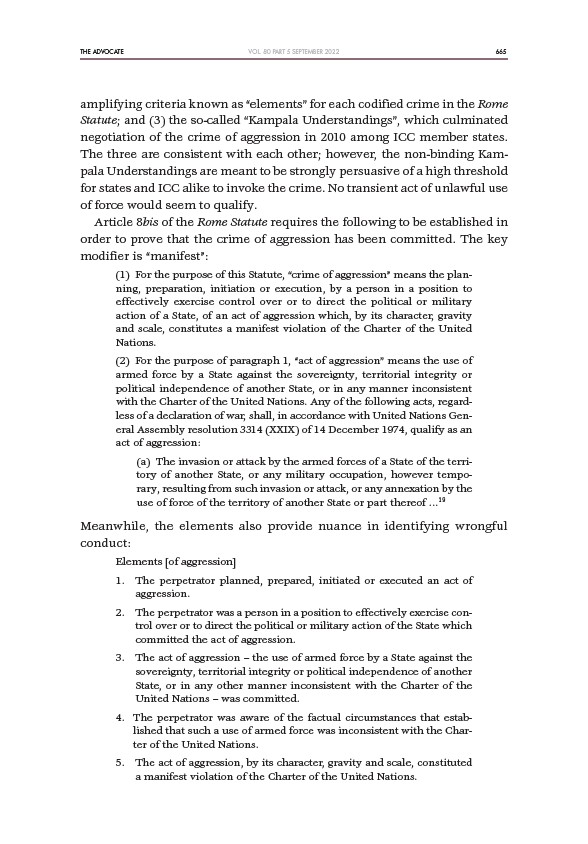
THE ADVOCATE 665
VOL. 80 PART 5 SEPTEMBER 2022
amplifying criteria known as “elements” for each codified crime in the Rome
Statute; and (3) the so-called “Kampala Understandings”, which culminated
negotiation of the crime of aggression in 2010 among ICC member states.
The three are consistent with each other; however, the non-binding Kampala
Understandings are meant to be strongly persuasive of a high threshold
for states and ICC alike to invoke the crime. No transient act of unlawful use
of force would seem to qualify.
Article 8bis of the Rome Statute requires the following to be established in
order to prove that the crime of aggression has been committed. The key
modifier is “manifest”:
(1) For the purpose of this Statute, “crime of aggression” means the planning,
preparation, initiation or execution, by a person in a position to
effectively exercise control over or to direct the political or military
action of a State, of an act of aggression which, by its character, gravity
and scale, constitutes a manifest violation of the Charter of the United
Nations.
(2) For the purpose of paragraph 1, “act of aggression” means the use of
armed force by a State against the sovereignty, territorial integrity or
political independence of another State, or in any manner inconsistent
with the Charter of the United Nations. Any of the following acts, regardless
of a declaration of war, shall, in accordance with United Nations General
Assembly resolution 3314 (XXIX) of 14 December 1974, qualify as an
act of aggression:
(a) The invasion or attack by the armed forces of a State of the territory
of another State, or any military occupation, however temporary,
resulting from such invasion or attack, or any annexation by the
use of force of the territory of another State or part thereof …19
Meanwhile, the elements also provide nuance in identifying wrongful
conduct:
Elements of aggression
1. The perpetrator planned, prepared, initiated or executed an act of
aggression.
2. The perpetrator was a person in a position to effectively exercise control
over or to direct the political or military action of the State which
committed the act of aggression.
3. The act of aggression – the use of armed force by a State against the
sovereignty, territorial integrity or political independence of another
State, or in any other manner inconsistent with the Charter of the
United Nations – was committed.
4. The perpetrator was aware of the factual circumstances that established
that such a use of armed force was inconsistent with the Charter
of the United Nations.
5. The act of aggression, by its character, gravity and scale, constituted
a manifest violation of the Charter of the United Nations.